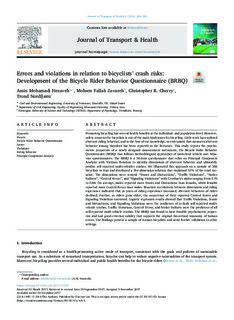| dc.description.abstract | Promoting bicycling has several health benefits at the individual- and population-level. However, safety concerns for bicyclists is one of the main hindrances for bicycling. Little work has explored aberrant riding behavior, and to the best of our knowledge, no instrument that measures aberrant behavior among bicyclists has been reported in the literature. This study reports the psychometric properties of a newly designed measurement instrument, the Bicycle Rider Behavior Questionnaire (BRBQ) that follows methodological approaches of motorized vehicle user behavior questionnaires. The BRBQ is a 34-item questionnaire that relies on Principal Component Analysis with Varimax Rotation to identify dimensions of aberrant behavior and ultimately predict self-reported multi-vehicles crashes. We illustrated this approach on a sample of 306 bicyclists in Iran and developed a five-dimension solution that explained 51% of the total variance. The dimensions were termed: “Stunts and Distractions”, “Traffic Violations”, “Notice Failures”, “Control Errors”, and “Signaling Violations” with Cronbach’s alpha ranging from 0.70 to 0.84. On average, males reported more Stunts and Distractions than females, while females reported more Control Errors than males. Bivariate correlations between dimensions and riding experience indicated that as years of riding experience increased, aberrant behaviors of riders declined. Further, as riders grow older, the occurrence of their reported Control Errors and Signaling Violations increased. Logistic regression results showed that Traffic Violations, Stunts and Distractions, and Signaling Violations were the predictors of at-fault self-reported multi-vehicle crashes. Traffic Violations, Control Errors, and Notice Failures were the predictors of all self-reported multi-vehicle crashes. The BRBQ was found to have feasible psychometric properties and had good criterion validity that supports the original theoretical taxonomy of human errors. The findings present a sample of Iranian bicyclists and need further validation in other settings. | nb_NO |

